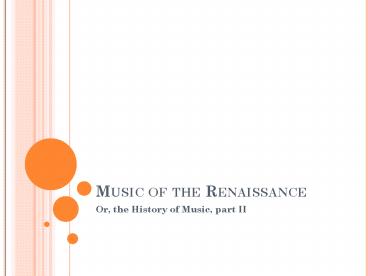Music of the Renaissance - PowerPoint PPT Presentation
1 / 23
Title:
Music of the Renaissance
Description:
... a shift towards knowledge and education. Mostly, however, the period is known for the arts ... Medieval composers did one line at a time, Renaissance ... – PowerPoint PPT presentation
Number of Views:295
Avg rating:3.0/5.0
Title: Music of the Renaissance
1
Music of the Renaissance
- Or, the History of Music, part II
2
The Renaissance on a World Scale
- It is a French word meaning rebirth
- This was a cultural shift in Europe between the
late 14th and 17th centuries, starting in Italy - The church lost power after the Hundred Years
War - Culturally, it encompassed a shift towards
knowledge and education - Mostly, however, the period is known for the arts
- Martin Luther, Leonardo da Vinci , Michelangelo,
Copernicus, Galileo,
3
(No Transcript)
4
But more on a Musical Tone
- Renaissance music describes the music during this
shift, usually written in the 15th and 16th
centuries - Like the end of Medieval times, music was
everywhere - During Renaissance, it was in every facet of life
- Any event/ceremony had music accompanying it
- Vocal music still used much more
A nice example.
5
More Musical Tones
- Melodies of the time were used with counterpoint
- Four voices in a piece became the accepted
standard - Harmony was still based on old church modes
- But, harmony was experimented with and changed
- Old Medieval forms were used, but new forms
developed
6
Polyphony continues
- Everyone remembers old Medieval polyphony, right?
- More voices were added to each line of a song,
adding depth - Four lines in a piece added much harmonic depth
- Parts no longer crossed, expanding ranges
- Similar themes were shared, making the music like
a conversation
7
More changes to music
- Imitation became huge
- One voice would state a theme, another would
repeat it, and so on, sometimes with modification - Dissonance made a debut in the Renaissance
- Medieval composers did one line at a time,
Renaissance did all lines at once - Dissonance was used for contrast and interest
before cadences, at dramatic moments, and weak
beats
8
Giving meaning to Music
- Words were no longer just in the music
- Text painting was developed using the mood of
the words to shape the music - Happy moments went up, sad went down
- Rhythm was freed, allowed to change and be more
spontaneous - Meters would mix, syncopation showed up
Some vocal work
9
Religious Music of the Renaissance
- The motet shifted toward being strictly
religious, thus joining the Mass as important
sacred music - Bottom voices were probably on instruments
- Rhythmic energy was more intense, phrases longer
- Masses developed the use of canon
- All in all, Mass became interesting again
- Famous dudes Dufay, Ockeghem, Josquin
10
Josquin
Some Josquin
More Josquin
11
Religious Music of the Renaissance
- After the Reformation, chorales/hymns became very
important to regular religious service - To counteract this, the Catholic church fought
polyphony yet again - Music would use dissonance sparingly, had
beautiful counterpoint, and avoided chromaticism - Other religious music developed in different
ways, using many strings as well as - Antiphony two groups playing back and forth
12
And now, Secular.
- Music was just as much a part of life as TV or
movies nowadays - It was expected that the upper and middle classes
develop musical aptitude - After dinner, family and guests would play for
the night, just for fun - This was all due in great part to the new
invention of printing music - The process was crude and expensive, and mostly
centered on vocal music
13
Secular continues in Italy
- Italy started taking over the musical scene
- Madrigals changed with the time, adjusting to fit
the stanzas and poetic lines they were based off
of - Madrigals became the popular form of
entertainment, written for five equal voices, and
concerned with all facets of love - They really utilized text painting
14
A name worth knowing.
- Claudio Monteverdi (1567-1643)
- His madrigals were the epitome of the time, being
some of the most famous and popular - He also is one of the first writers of opera
- He used a very dramatic style
- Serves as a link in to the Baroque era (coming
soon!)
15
Monteverdi
An example Yet another example
16
Somewhere else not France
- England finally enters the music scene
- Monteverdis music traveled across Europe,
reaching England finally - They loved it, then started writing their own
- The madrigals werent just about love, but all
drama, good and bad - Thomas Morley one of Englands first (only)
composers
17
Morley
A madrigal And then something else
18
Renaissance Instruments
- They had two classifications haut and bas
(loud and soft) - Flutes were used, as were a great range of
recorders, from tiny to huge - Others of the time trumpet, sackbut, cornetto
- Viols, lutes, and guitars were the common string
instruments of the time - Drums, bells, and cymbals added percussive flavor
- Music could be played by all like instruments, or
a mixture of families (consorts)
19
You can dance if you want to
- Early pieces were transcriptions of vocal work
- Instrumental music was primarily used for dances
- Pavane slow, duple meter dance, followed by
- Galliard quick, leaping dance in triple meter
- The two dances would be variations on the same
tune - Organ and harpsichord were growing in popularity,
especially in Germany
20
Wind Instruments
21
String Instruments
22
Percussive Instruments
23
Keyboard Instruments






























